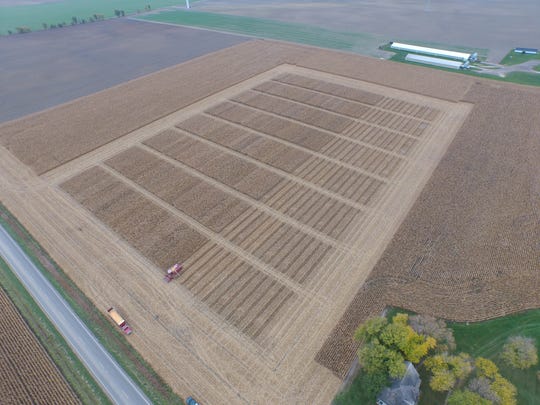From sodbuster plows to GPS-guided combine harvesters, agriculture has long been on the cutting edge of technology. Now, some producers are getting an eye in the sky so they can better monitor their crops.
Corey Oeschger farms 1,000 acres at Maplehurst Farms near Bay Port in Huron County. He uses drones to keep an eye on crops such as corn, winter wheat, soybeans, dry beans and sugar beets.
He also operates a company called Thumb Drone Works.
"My day job is farming," he said. "The Thumb Drone Works, I guess you would call it a hobby that blew up is the best way to describe it."
Oeschger said he started flying drones for fun, but it wasn't long before he realized the small radio controlled aircraft could be used in agriculture.
"In the springtime, we like to use the drone," he said. "We fly over a lot of our bare-ground fields and look at the drainage tile to see if there’s any broken tile or if we need to add some tile to help the field drain better."
He said he uses drones to monitor winter wheat after applying fertilizer and nitrogen in the spring.
"When you're in a wheat field, an 80-acre wheat field, and I flew up to take a look at it, and in the middle there was something that you wouldn't have seen from the road," he said.
"There was a yellow strip where they happened to miss applying fertilizer. It showed right up, so we were able to go out with some fertilizer and fill in that hole that was nitrogen deficient.

A drone flies over a farm field in the Thumb. (Photo: Thumb Drone Works)
"That right there payed for the drone," he said.
Besides drones equipped with standard video and still cameras, Oeschger also flies aircraft with thermal imaging and normalized difference vegetation index cameras, also known as NDVI.
The NDVI equipment, he said, gives a picture of how the plants are producing chlorophyll. The thermal imaging cameras show hot and cool areas and can be used to detect plant disease and to monitor irrigation needs.
He said he uses drones throughout the growing season to monitor the crops.
"There are a lot of things you can see from the air that you can’t see from the ground," he said. "When it (corn) is over your head, it’s kind of hard to see how the whole field looks walking through it."
Oeschger said he uses a DJI Inspire and a DJI Phantom, which are both quadcopters with four rotors. He also sells that brand of drone.
He said he started his drone business looking at drainage tile for other farmers, but many producers have now invested in their own aircraft and that drone use is not uncommon in Michigan agriculture.
"Most of the farmers who are using them, they go up and take a picture of their fields in the spring," he said. "And it’s always fun to look at your equipment as it's going through the fields."

A photo taken from a drone shows a harvest operation. (Photo: Thumb Drone Works)
He said when he started in 2012, he did a lot of flying for other farmers but that part of the business has decreased.
"If a farmer wants a drone, he’s going to go out and buy one," Oeschger said. "My business now is more sales than custom work, but I still do a little bit of custom work."
Contact: Fly Dragon Drone Tech.
Email: frank at dronefromchina.com
Add: NO. 9 Dayu Road PiDu distric, ChengDu 611730, China